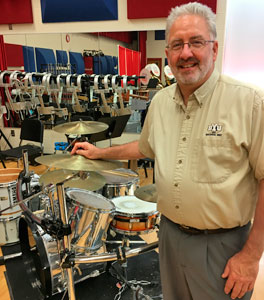Pick up a copy of the newspaper your local newsstand.
![]()
PAGE UPDATED BY MARIA SIEVERDING APRIL 25, 2017 1 P.M.
Eagles in harmony
JCD band thrives with community support, dedicated director, and engaged students
Jared Rogers
CONTRIBUTING WRITER
“I custom designed the band room myself,” Jac-Cen-Del (JCD) band director Glenn Unklesbay shares as he walks into his room in the high school, a part of the most recent school renovation. “Sound reverberates for less than one second in here.” The room is stocked with an array of common band room items, like percussion instruments, chairs, and music stands, but it also has several specific features built in, lending to quality sound.
 JARED ROGERS PHOTO
JARED ROGERS PHOTO
Pictured left is Glenn Unklesbay in his custom-designed band room.
For example, several soundproofing panels hang on the walls. Unklesbay shows a cool experiment. He says that some of the fixtures absorb sound, while others reflect it. If you put your nose close to the different panels and shout your name, a red, rectangular box appears to suck the sound directly from the mouth into the wall; while a blue, convex feature bounces sound past the ears and ringing into the room. Through discussing additional design details, it is apparent that Unklesbay is an expert of his craft. Unklesbay, who has been at the helm of JCD’s band for 14 years, has held music at the central focus of his life for over 46 years. He first played the drums at age 12, and he’s been playing his current drum set since 1975. “It’s worth more now than when I bought it,” he laughs.
Unklesbay credits his high school band director, Jim Wright, of Christian County High School in Hopkinsville, Kentucky, with instilling the love of music in him. He remembers warmly the opportunities he was afforded through participation in band that he might not have otherwise had. He relates that this is also the most rewarding aspect of his job today: Opening the eyes of his students by exposing them to a variety of experiences through the band.
Upon listing a few of his crew’s most recent performances, it is clear to see they are a busy band, indeed. The marching Eagles are hot off an annual performance at the Cincinnati Reds’ Opening Day parade, and they’ve performed at an Indiana Pacers game for each of the previous three seasons. In the fall, the band travels to play in college football halftime shows, including at Indiana University and the University of Cincinnati. The band has three big shows approaching soon. They earned a spot in the Kentucky Derby parade on May 4, one of the premier parades in the country that is broadcast to over 1.5 million viewers around the world. Their annual spring concert will be held on May 10, which the public is welcome to attend. Then, on May 20 they plan to march at King’s Island.
It is stunning to note that students of Mr. Unklesbay’s band do all of this without a single after-school practice. Instead, they are encouraged to participate in any of JCD’s after school clubs and sports. Further, Unklesbay is proud to share that most often, by the time the band is at a performance, he has little to do. His squad is prepared and ready to go when the time comes. Finally, in a time where school bands are declining in participation, JCD boasts 74 members this year, and projects 87 next year. As a reference, the band had 31 participants when Unklesbay arrived.
How can all of this be possible? “We do things differently here,” Unklesbay smiles. He’s talking about ‘Discovery Band’, a program made possible thanks to the Reynolds Foundation. “Every student, beginning in 5th grade, takes band,” he says. “There is no payment for an instrument or book. Students who may have never had the chance to discover an innate talent for music are allowed that opportunity at our school.” As a student progresses in school, they can choose whether or not to remain involved with the band, and it seems that many find it worthwhile. In addition to giving every student a chance to play, Unklesbay stresses the importance of reading music as a cornerstone to his band’s success. He says that too often, students learn to mimic instrument fingerings rather than actually learn to read music, a bad habit that hinders the ability to improve over time.
When reflecting upon his career at JCD, Unklesbay offers gratitude. First, to Ray Ratledge, “who took a chance on me,” he says, referring to being hired as band director after spending 11 years away from teaching. Second, to Bill Craddock, JCD’s Maintenance Director, who drives the band’s equipment truck and trailer everywhere they go. “He even drove it down to Walt Disney World,” Unklesbay grins, referring to a trip that the band takes once every four years.
One may wonder how a band which has seen so much growth can sustain, but Unklesbay assures, “I’m always dreaming - always looking for something new to show the kids.” Behind the twinkle in his eyes one can almost see the gears turning.
‘Repeal and Replace’ fails; now Obamacare needs fixing
 Judy Lieberman
Judy Lieberman
RURAL HEALTH NEWS SERVICE
The failure of the Republican-led effort to repeal and replace Obamacare represents a big victory for all kinds of citizens and interest groups that analyzed the proposed legislation and said no dice. The day before House Speaker Paul Ryan decided not to take a vote on the American Health Care Act, a Quinnipiac Poll found that only 17 percent of American voters approved of the GOP’s legislation while 56 percent did not. You can hardly call that a vote of support for what the bill was trying to do. Too many people would be hurt, and the public along with editorial writers in newspapers across the country, got that message: The GOP plan would cause real pain. Members of Congress heard it loud and clear, and many responded to what they heard.
Older Americans would have had to pay more, sometimes thousands of dollars more to get health insurance. In 32 states, millions of Americans with incomes slightly above the poverty line who had gained coverage under their state’s Medicaid expansion program would have lost their coverage. Others already on Medicaid or joining in the future would also have been affected. The proposal called for cutting back the federal government’s commitment to fund healthcare for the poor by changing the way it would pay for its share of program. That would have left the states, which jointly fund Medicaid, strapped for funds to cover everyone needing medical treatment as well as middle class families who required help paying for long-term care. Medicaid pays for about half of all nursing home stays.
The Affordable Care Act (ACA), or Obamacare, had mandated that every insurance policy sold in the individual market where people without employer or government coverage must shop had to include 10 essential benefits. Under the Republicans’ plan, that mandate – that all plans include things like prescription drug coverage, emergency room services, maternity care and mental health treatment – would have disappeared. Dropping any of the essential benefits would have helped some insurance companies whose individual policies provided only bare bones coverage until 2010 when the ACA required essential benefits to be included. Insurers would have been able to sell skimpy and cheaper coverage to those willing to gamble. Now, even though the “repeal and replace,” effort failed, we are left with a health law that needs repairs of its own.
“Many of the criticisms of the ACA are, in fact, valid,” says RoseAnn DeMoro, executive director of the National Nurses United, the largest union and professional organization of registered nurses. “For all the improvements under the ACA - primarily the expansion of Medicaid and crackdown on some insurance abuses - the ACA still left 28 million without health coverage - and millions more struggling with unpayable bills and escalating out-of-pocket costs.” DeMoro’s assessment hits home to many readers of this column who have complained about higher and higher premiums, sky-high deductibles and coinsurance, and lack of choice. Many have limited choice of doctors, hospitals and other providers in insurers’ restrictive networks. Even worse, in some parts of the country there’s only one insurer to buy from.
Those problems stem from the underlying premise of Obamacare itself. The ACA was built on top of the existing private insurance system, which means that it will work only if insurers find it to be good business. As the years went on and sick people with pre-existing conditions flocked to buy coverage, which the law guaranteed they could do, insurers found that Obamacare was not good business. They left the market or made consumers pay more out of pocket or through higher premiums. The ACA did not provide for any serious cost containment, and the GOP plan didn’t call for any either. Medical inflation continues as doctors, hospitals and drug companies raise their prices, and new expensive medical technology comes on the market before there is good evidence that it works. One consulting actuary put it this way, “Medical inflation will continue until doctors decide they have enough money and don’t raise their fees.”
It’s not clear that the country’s divisive politics will allow for any fix of the ACA’s problems, let alone put any teeth into cost control measures. There could be renewed interest in a public option that could allow people to choose government-sponsored insurance rather than a policy from a commercial carrier. Or maybe there would be a move to let people in their 50s or early 60s buy into Medicare, which could spark the beginning of a movement toward Medicare for All.
I’m not betting on any of this right now, but as the failure of the GOP’s “repeal and replace” shows, the public is demanding a seat at the table.
How would you fix the Affordable Care Act? Write to Trudy at trudy.Lieberman@gmail.com. --The Rural Health News Service column is provided by the Hoosier State Press Association Foundation.














